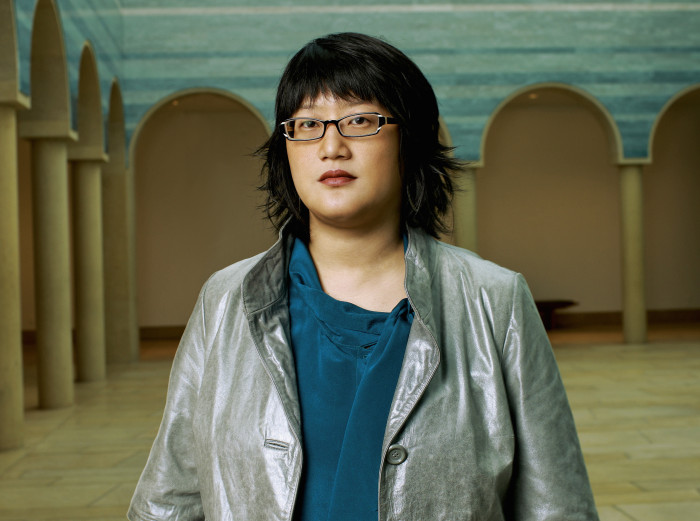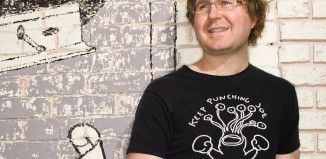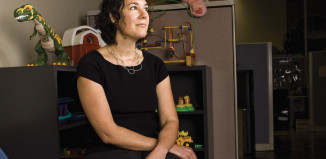Everything a person experiences affects his or her life. For Aimee Chang , that’s a good thing. With a family and personal background that encompasses science, fine art, literature, cultural studies, community involvement, and art education, it’s no wonder that she has found a perfect job at the Blanton Museum of Art as director of public programs. In that post, she is in charge of making the Blanton’s exhibitions transparent to the rest of the city. She does that by involving many cultural disciplines.
Chang is an easygoing person with an engaging smile. But as she talks about the Blanton, it’s obvious that she has serious, wide-ranging interests and she knows how to effectively combine many ideas.
That cross-disciplinary bent started in her childhood. She grew up in that hotbed of free-wheeling thought: Berkeley, Calif. Her father had a master’s degree in microbiology.
“But my father had always been an artist,” she said.
When Chang was a child, her father decided to go to the California College of Arts and Crafts (now the California College of Art) and work on a bachelor of fine arts degree.
“So I grew up watching him doing student shows and i went to the museum with my parents to see a lot of exhibitions,” Chang said.
At home, Chang was playing with clay, paintings and drawings. “That formed my interest in art,” she said.
But Chang was also an avid reader and she earned her bachelor’s degree in world literature and cultural studies at the University of California, Santa Cruz.
If all that wasn’t a rich enough stew of culture, she came to Austin and the University of Texas to work on a master’s degree in art education.
The subject she chose for her master’s thesis – Rick Lowe’s Project Row Houses in Houston – sparked her interest in community involvement with artwork. This transformative work involved rehabilitating homes in Houston’s third Ward and then inviting artists to do six-month projects there.
After completing her master’s degree, Chang put together an impressive work history in Minneapolis and Los Angeles. In her last job at L.A.’s Hammer Museum, she was the director of academic and residency programs. She oversaw the engagement of artists with the communities and resources of Los Angeles, the Hammer and UCLA.
With that experience under her belt, it felt right for her to forsake L.A.’s freeways and return to Austin when the position at the Blanton became available.
As she sees it, her task with public programs is to attract people who have different perspectives on the work being shown while broadening its experience and art appeal.
Since accepting the post at the Blanton last July, she’s been busy delivering a number of ambitious initiatives toward those goals. In the current exhibition on “Desire,” Chang ’s intensive study of literature is evident.
For the exhibit’s opening in February, Chang invited two of the artists, Marilyn Minter and Glenn Ligon, to speak on desire, and UT professor James Loehlin (who is the director of Shakespeare in Winedale) spoke on “Shakespeare and desire.” The catalogue also has a number of writers including Sarah Bird, Dan Boehl, Kurt Heinzelman, Jim Lewis, Wura- natasha Ogunji and Flint Sparks, who will present a “writing desire” discussion on the last day of the exhibition, April 25. All of these events help to expand the interaction with the exhibition’s viewers.
“I’m trying to bring more artists out to give talks,” said Chang. “Through April we’ll be presenting three artists, two from New York and one from Los Angeles.”
One of them, Walead Beshty, is a photographic artist whose work was influenced by the 1978 George Romero film, “Dawn of the Dead.” Beshty’s work centers on “modern ruins” such as empty shopping centers and the abandoned Iraqi mission in east Berlin.”
Chang said the Blanton is also starting to show artists’ own videos. For instance, the museum will show a movie by conceptual artist Dan Graham called “Rock My Religion.” Made in the early 1980s, the piece looks at rock’ n’ roll as a religion and focuses on the singer-songwriter Patti Smith.
“These are the types of videos you can’t just go to a local store and find,” she said.
Chang is even bringing in culinary experts such as Diana Kennedy to illuminate exhibitions. Kennedy, author and food historian, will present “Unknown gastronomy of Mexico.” Her talk will be in conjunction with “Another image of Mexico: Photographs by Manual Alvarez Bravo and His contemporaries.” She will focus on the vital role of recipes passed down from generation to generation.
A mission like Chang ’s requires having an excellent product to sell. So what strengths of the Blanton does she see?
“First, since the Blanton has a serious collection of artwork, it allows the staff to teach from it and to explore it in a deeper manner rather than having pieces which are brought in for a limited time and then are gone. It’s also important that the Blanton is connected to UT and we can draw from the intellectual resources here,” Chang said.
She notes that this is an especially exciting time since the museum has a new director and that, throughout the next couple of years, new directions for initiatives will emerge.
“Also, our location on the border between the university and the rest of the city lets us access both communities,” she said. Chang feels Austin is a creative community, which makes it an especially stimulating place for a museum. She is cultivating with local arts groups like the Austin Film Society. Chang realizes she is involved with a fantastic institution. And she’s doing everything she can to make certain that the rest of the world knows realizes it too.




































